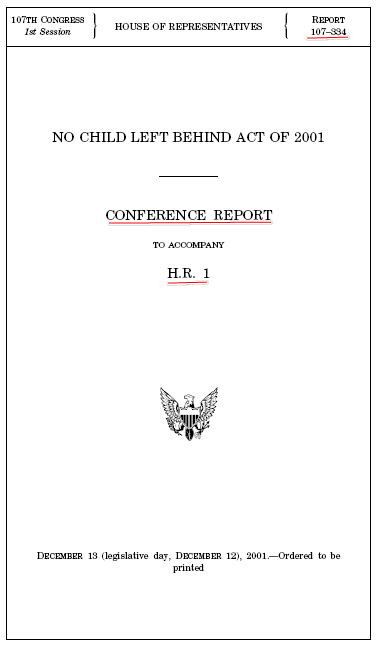
Committee Reports:
A committee's report on a bill is considered one of the most important pieces of a legislative history. Most bills die in committee, but House and Senate committees do report some bills for consideration by the full chamber (though only the House requires the production of a written report). A report can provide insight into the committee's intent with respect to specific sections of the legislation. Committee reports are issued as:
H. Rep.__-___ or S. Rep.__-___.
Conference Committee Reports:
If the House and Senate bill versions differ, a conference committee with members from both chambers is convened to work out a compromise. The accompanying report is equal to the committee report in importance, but it only addresses the differences between the House and Senate versions. It is valuable for determining the intent of the conferees. Conference reports are issued as house reports and are always reprinted in the Congressional Record, usually on the day it is filed.
Please note, access to certain databases linked in this guide may be restricted to UT Law or the UT community; please see the library's Databases page that lays out access privileges.
Review this example to see a report's standard elements:
Bluebook citation, Rule 13.4: H.R. Rep. No. 107-63 (2001).

View full-text at GPOAccess.
Review this example to see a conference report, which usually has two parts:
Bluebook citation, Rule 13.4: H.R. Rep. No. 107-63 (2001) (Conf. Rep.).

View full-text at GPOAccess.
Researchers can access reports through multiple sources. For an overview of the committee reports and the serial set please see LLSDC's website.
If you wind up needing a hearing or report in microfiche from CIS (via ProQuest Congressional or Lexis), then you will find it using what is called an "accession number." CIS was a commercial publisher (now part of ProQuest) that sought to make congressional information more accessible via indexing and microfiche reproduction. As part of this process, CIS assigned accession numbers to congressional documents as they processed them. Understanding the code behind the numbers can help in homing in on the right microfiche.
The numbers are assigned each year and have five parts. For example, while it is not printed in the document itself, the CIS accession number of the sample report pictured on this page (regarding the No child Left Behind Act of 2001) is H343-6. The first part of the accession number is actually a letter indicating the issuing body: H=House, J=Joint, and S=Senate. The second and third parts identify the committee or special category. This sample hearing was issued by the House Committee on Education and the Workforce, whose designation is 34. The fourth part indicates the type of document (1=hearing and 3=report). So now we have H343. The last part after the dash is simply the numerical order of issuance in a given year, hence H343-6.
When looking up a statute in West's USCA, you will usually see--below the statutory text--the heading "Historical and Statutory Notes" with the subheading "Revision Notes and Legislative Reports." These "Legislative Reports" are reports on a bill from a Congressional committee. It is here that USCA, unlike the official USC or Lexis' USCS, may provide citations to some (but not necessarily all) relevant reports, along with an accompanying citation to where you can read an excerpted version in USCCAN.
The Conference Committee met six times before issuing its final report on the No Child Left Behind Act, dated Dec. 13, 2001. As an example of how committee meetings are conducted, below is C-SPAN footage from the second meeting on Aug. 1, 2001.
U.S. Code Congressional and Administrative News (USCCAN) is a unique resource published by West, available on Westlaw. It offers two sets of volumes per Congress: one set is a reprint of the Statutes at Large and the other set is labeled "Legislative History," containing lists of citations, abridged reports, and presidential signing statements.
Thus USCCAN has characteristics of both a compilation and a list of citations. However, because it reprints only highlights from a law's legislative history, it is not a comprehensive source as either a compilation or a list. Still, it can be quite convenient to use--you will find references to the relevant portions of USCCAN listed by section in the USCA. Because it focuses on the highlights, it can be a good first source to check.
